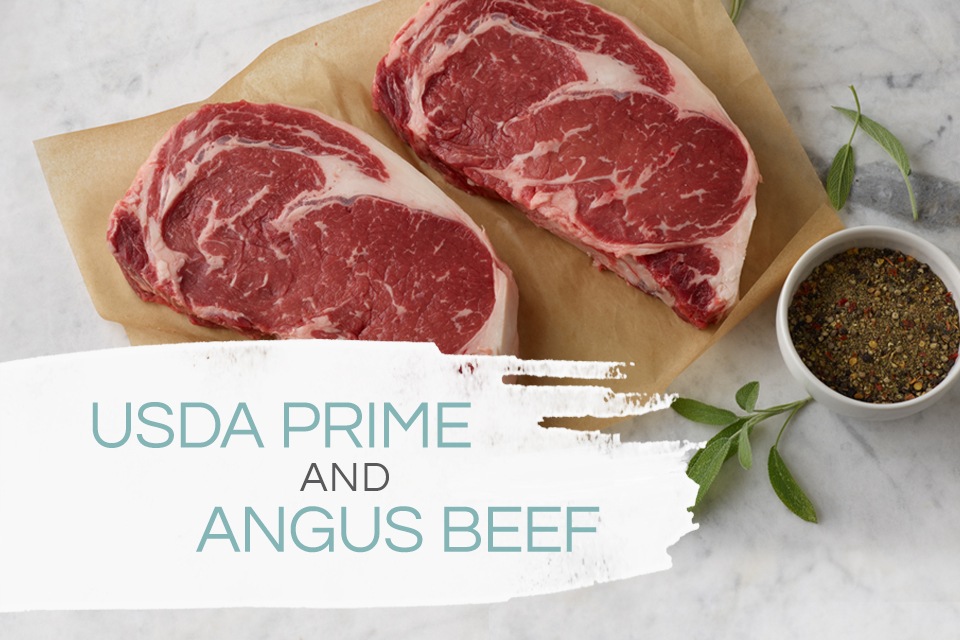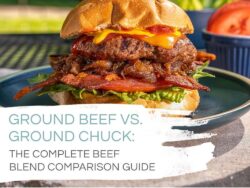
USDA Prime Beef vs. Angus Beef: What’s the Difference?
Mar 19, 2020 | Cooking with Beef, Natural Angus Beef
When it comes to buying beef products, we have more options than ever to choose from—in the past, Americans mainly focused on the cuts they needed to make a particular meal. Now, with over 26 billion pounds of beef produced in the U.S. every year and various claims appearing on beef products, choosing our beef isn’t always as straightforward. How do you find flavorful, quality beef? What do the USDA beef labels mean? Is Angus beef better than USDA Prime, or just different?
We’ve broken down the differences to help you be more confident in your beef purchases.
USDA Prime Beef: The Basics
USDA Prime is a classification based on the quality and marbling of beef. It’s a standard for beef, rather than a type. The USDA Prime label can apply to grass or grain-fed cattle of any breed, although some breeds tend to qualify as USDA Prime more often than others.
USDA Beef Grades: Prime vs Choice vs Select
USDA Prime is part of a grading scale that the USDA’s Agricultural Marketing Service determines and maintains to ensure products of quality and integrity. There are three official grades on this scale: Prime, Choice, and Select.
- USDA Prime: Produced from well-fed, young cattle, Prime is the USDA’s highest grade, featuring abundant marbling (flecks of fat within the meat that makes it more flavorful).
- USDA Choice is the second-highest grade, with flavorful, tender cuts but with less marbling than USDA Prime.
- USDA Select is the most widely produced but doesn’t have the tenderness and marbling of beef in the other classifications.
Although the grades can include beef from various breeds and brands, several factors affect whether beef falls into one of these categories. Raising practices, age at finishing, diet, genetics, and more can result in varying levels of marbling and tenderness.
How to Tell if Beef is Prime, Choice, or Select
The USDA grading shield indicates which classification applies to the product. Here’s what beef in those categories can look like:

What is Angus Beef?
Angus is a breed of cattle known widely for its marbling, consistency, and juicy flavors. While it can—and often does—fall into one of the top USDA classifications, Angus is a breed, not a third-party standard or type of meat. It’s a factor you should consider in addition to the USDA classification instead of as opposed to a particular grade like USDA Prime.
Angus Vs Prime: Beef Can Be Both
Since Angus is a breed and USDA Prime is a grade of beef it’s not a “this vs that” comparison. Angus beef can be graded as USDA Prime but could also grade as “Choice” or “Select.”
Beef sourced from Angus cattle is often high quality, but diet, genetics, and handling practices all contribute to the final product.
How Do You Know Which Beef to Choose?
Doing some quick research will help you find a quality beef product. Understanding the USDA classifications and differences between types of beef is a good first step. You’ll also want to investigate beef brands and consider their feeding and handling practices.
A Cut Above
At Aspen Ridge, we’re committed to producing high-quality Angus beef to USDA Prime and Choice standards. That’s why our cattle have verifiable Angus genetics and are also source and age verified. Our ranchers follow strict feeding and handling protocols, and our cattle have ample room to roam.
The result? A truly natural product that provides unprecedented flavor.
Aspen Ridge Natural Angus Beef Grades
Our naturally raised beef routinely surpasses conventional beef in meeting top USDA standards, and Angus genetics ensure tenderness and rich flavors.

Add Mouthwatering Natural Angus Beef to Your Next Meal
Try one of these tasty recipes or learn more about the difference of Aspen Ridge Natural Angus Beef.



